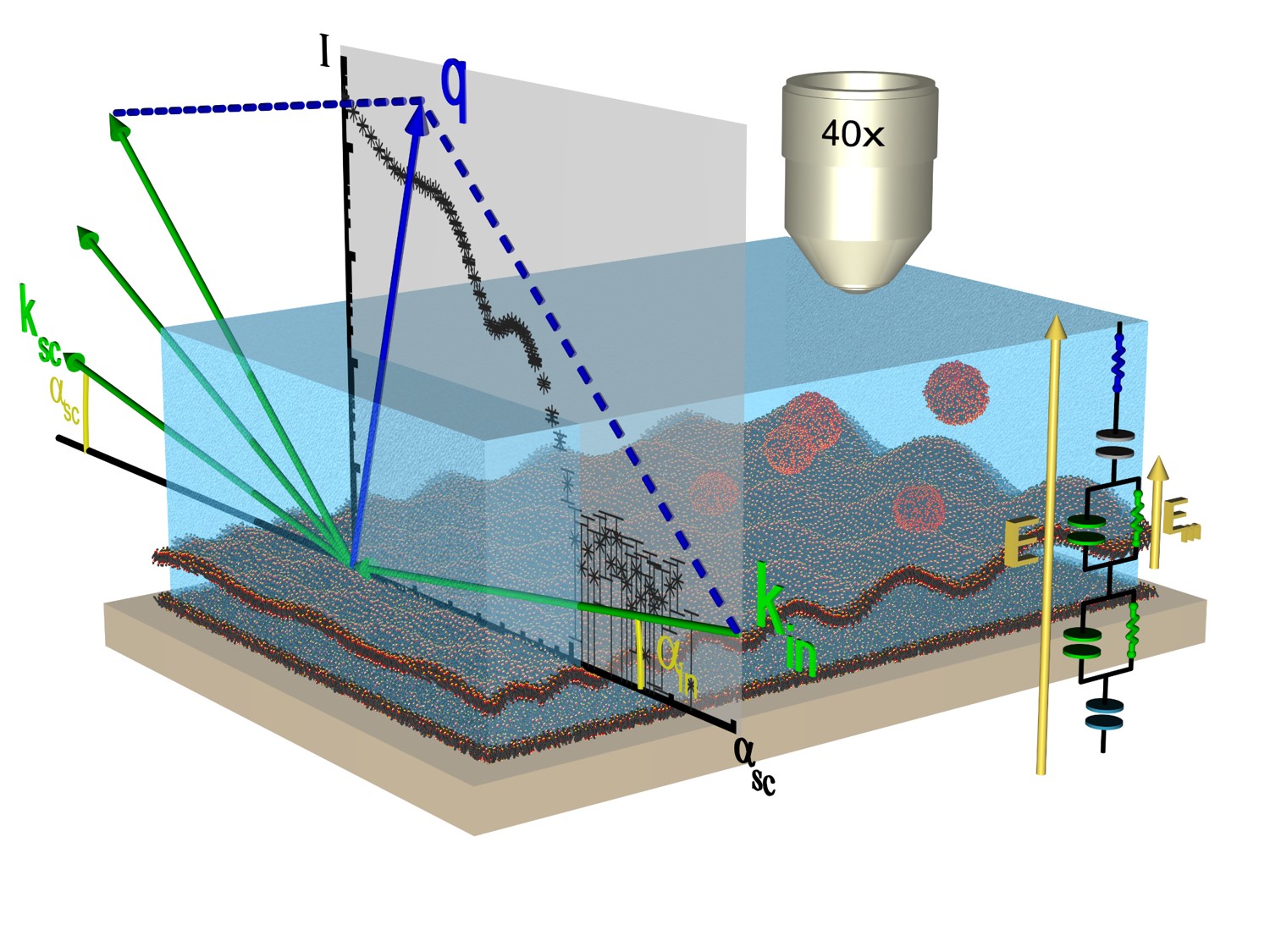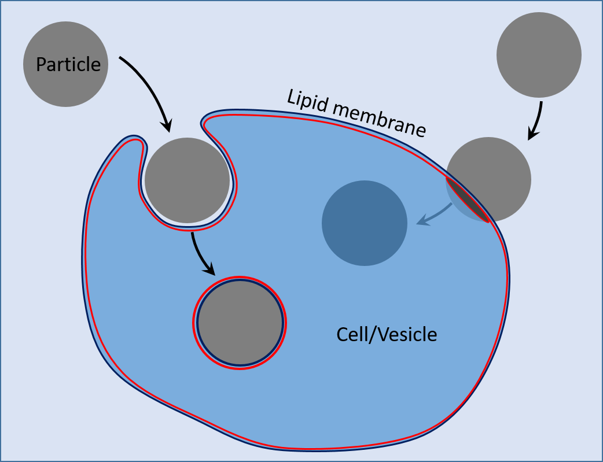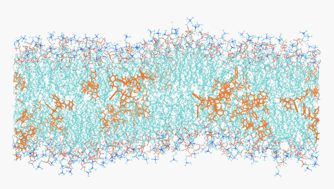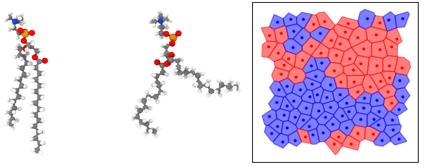Institut Charles Sadron MCUBE
Research

Visit Mcube Team website
Mcube research themes fit harmoniously within the Charles Sadron Institute’s priority research areas:
- Fundamental aspects of polymers and soft matter
- Self-assemblies
- Soft matter at interfaces
Active Systems
Antonio Stocco, Pierre Muller, Tatiana Schmatko, Thierry Charitat, Igor Kulic
External collaborations: Université Paris (Ali Abou-Hassan), Dresden (Juliane Simmchen, Germany), Haute-Alsace (Laurent Pieuchot, Mulhouse), ILL Grenoble / ESS Lund (Giovanna Fragneto), Synchrotron Soleil (Jean Daillant).
In the coming years, we plan to experimentally study situations involving interactions between solid particles and out-of-equilibrium interfaces, whether due to local energy consumption or to the presence of a thermal or physico-chemical gradient. Giant vesicle lipid membranes and liquid–solid interfaces will be the two preferred interfacial geometries in these studies. Giant vesicles will be used because of their propensity to undergo complex transformations such as endocytosis, morphological transitions, division, budding, etc. A first project, supported by ANR PRC EDEM (2020–) funding, enables the systematic study of interactions between active particles and giant vesicles. The solid counterpart may take the form of traditional Janus colloidal active particles, whose activity relies on the decomposition of hydrogen peroxide catalyzed at one of their surfaces.
In this way, we aim to study and reproduce the dynamics of viruses, bacteria, and other colloids in contact with biological membranes in processes such as microbial infection, drug vectorization, and the toxicity of certain nanomaterials. Normally, membranes act as barriers opposing the internalization of foreign compounds. During endocytic processes, the lipid membrane envelops the foreign body, then closes and seals the junction with the outer membrane.

Figure 1: Schematic representation of an endocytic process.
In the previous years, Igor Kulic and collaborators highlighted the possibility of animating simple plastic fibers with a sustained rotational motion capable of providing mechanical work equivalent to that of a miniature motor (fiberdrive). It quickly became clear that this was a universal mechanism for converting a physico-chemical gradient (thermal, hydration, osmotic, etc.) into work and motion. The idea was soon extended to the study of the active mobility of viruses of anisotropic shape or colloids.
The central question raised by these studies is how to reach a general understanding of how biological or biomimetic systems can respond to environmental gradients and convert them into actuation, motion, or self-organization. A Franco-German ANR-DFG PRCI RodRolls (2020–) project aims to reproduce an analogue of the presumed rotational motion of filamentous viruses using colloidal rods stimulated by a chemical or light signal.
The phenomenon of motion initiation is based on a bifurcation from a resting state to a self-sustained dynamic state, whose direction of rotation is neither predetermined nor encoded in the studied object. The choice is therefore random and spontaneous at the start, with the dynamics depending on a stability diagram controlled by external forcing and dissipation. It will be particularly instructive to address situations in which obstacles perturb the motion, in order to determine to what extent these active dynamics are resilient or fragile.
We are also interested in the cooperative amplification of the response of systems sensitive to physico-chemical or thermal environments. An appropriate arrangement of responsive units can lead to spectacular conformational changes. Such cooperativity has already been demonstrated in biological filaments (actin, microtubules, intermediate filaments). We are currently studying the particular case of bacterial R-bodies. These are subcellular organelles shaped like rolled ribbon-sheets, capable of transitioning from the rolled to the extended state in response to pH variations.

Figure 2 : Left – schematic representing the insertion of a bacteriorhodopsin into a supported double bilayer. Right – viral membrane performing an active rotational motion.
The final emblematic project concerns the study of lipid bilayers rendered active by the insertion of a bacterial protein complex called bacteriorhodopsin. This membrane protein complex is responsible for energy photosynthesis in purple bacteria and uses a non-chlorophyll pathway. It can be artificially reconstituted within a supported double lipid bilayer and studied using off-specular reflectivity methods, long mastered within the team (collaboration with Soleil, ILL, ESS). This has already enabled, for example, the measurement of mechanical couplings between activity and the collective modes of a bilayer.
Friction
Pierre Muller, Thierry Charitat, Fabrice Thalmann, Antonio Stocco, Marc Basler
Internal collaboration: MIM (Damien Favier, Anne Rubin, Christian Gauthier)
External collaboration: ILM Lyon (Claire Loison, Laurent Joly)
The measurement of forces and the determination of their origins have always been a core aspect of physics. Forces and other mechanical actions of varying dimensionality (line tension, surface tension, stresses) emerge in response to matter displacement or physico-chemical heterogeneities. For example: the surface tension of a fluid, or the mechanical effects of a hydration gradient during the imbibition of a lipid deposit (gel swelling) or during the drying of a concentrated colloidal suspension (film formation).
We have undertaken detailed studies of the mechanisms accompanying the relative displacement of two surfaces coated with a molecular film of phospholipids and the resulting friction stresses. This class of systems is known for exhibiting low friction coefficients, a mechanism exploited in living organisms to allow relative sliding motion between two tissues, known as biolubrication. Our project aims to measure as precisely as possible the sliding velocities accompanying friction between macroscopic surfaces.
The project also has an essential theoretical and numerical component. Our team studies friction at the molecular scale in phospholipid bilayers and collaborates with a team at ILM Lyon. At this scale, dissipation mechanisms linked to linear response theory predominate. A conceptual effort is therefore required to link molecular-scale measurements to macroscopically measured friction coefficients. TriboFrapp is not the only instrument we have for measuring frictional forces: we also have optical tweezers for nanoscale measurements, enabling us to manipulate vesicles and membranes directly.
Polymer–Membrane Interactions, Membrane Toxicity of Nanoplastics
Antonio Stocco, Fabrice Thalmann, Tatiana Schmatko
Internal collaboration: Marc Schmutz (Sycommor)
Polymers and membranes are central objects in soft matter physics, dual in their dimensionality and in permanent interaction. The presence of polymers near membranes can be intentional, as in the case of grafting a hydrosoluble chain onto the head of a lipid (typically PEGylation), or accidental, as when the environment brings chains into contact with a lipid bilayer in the form of nanoparticles or soluble chains (for example, amphiphilic peptides). Polymer–membrane interaction mechanisms are rich and involve entropic, elastic, hydrophobic, and electrostatic effects.
Our contribution to the polymer–membrane theme takes several forms. At the macroscopic scale, optical tweezers allow us to bring polymer nanoparticles (polystyrene, melamine, etc.) into contact with giant vesicles of chosen composition and to quantitatively measure the forces induced by the interaction. This enables a broad variation of physico-chemical properties (charge, adhesion, wetting) at the nanoparticle–membrane interface. The study of coating and interactions between smaller nanoparticles was the subject of a collaboration with the Sycommor team.
Following a recent contribution on polystyrene–membrane interactions, we wish to address within the team the question of the possible nanotoxicity of microplastics in the environment. We approach this theme from the perspective of the penetration of oligomers and hydrophobic polymers into the core of a bilayer and the study of the resulting structural, thermodynamic, and dynamic modifications. An initial significant experimental study has clarified some points regarding sample preparation and demonstrated the existence of penetration processes.

Models: Theory, Simulations and Artificial Intelligence
Fabrice Thalmann, Igor Kulic, Jean Wolff
Internal collaboration: Marc Schmutz (Sycommor), Olivier Benzerara (TSP)
External collaboration: Vivien Walter (King’s College London), Céline Ruscher (University of British Columbia, Canada)
Our team favors problems where theory and experiment are complementary, and we systematically attempt to interpret the experimental results we obtain using existing or original models. This common approach in complex systems research is often referred to as phenomenology. For instance, experimental studies on lipid hydroperoxidation have led to interpretations and the development of original coarse-grained molecular dynamics models.
Interpretation of perturbations in lipid fusion transitions caused by hydrophilic or hydrophobic agents has led us to study these phase transitions closely using simulations and to interpret them with original Machine Learning approaches. We will continue in this direction by using convolutional neural networks (CNNs) to interpret molecular dynamics trajectories of lipid bilayers in the presence of external agents (nanoplastics, hydrophilic compounds). Machine Learning / AI classification of lipid conformations will provide a robust framework for interpreting these dynamics.
More broadly, we will also use these advanced statistical analysis methods to interpret cryo-TEM images of liposomes (peroxidized or exposed to perturbing agents) to improve contrast through statistical addition.
Traditional theoretical themes will also be pursued, such as understanding microscopic interactions and the thermodynamics of lipid mixtures, curvature–concentration couplings in membranes, the study of solution drying, and deformation of polymer particles under the influence of surface tension and applied external pressure.

References
[1] F. Frey & T. Idema, More than just a barrier: using physical models to couple membrane shape to cell function, Soft Matter 17, 3533–3549 (2021).
[2] J. Agudo-Canalejo & R. Lipowsky, Critical particle sizes for the engulfment of nanoparticles by membranes and vesicles with bilayer asymmetry, ACS Nano 9, 3704–3720 (2015).
[3] S. Zhang, H. Gao & G. Bao, Physical principles of nanoparticle cellular endocytosis, ACS Nano 9, 8655–8671 (2015).
[4] A. Baumann et al, Motorizing fibres with geometric zero-energy modes, Nature Materials 17, 523 (2018).
[5] A. Bazir, A. Baumann, F. Ziebert & I. M. Kulic?, Dynamics of Fiberboids, Soft Matter ,16, 5210 (2020).
[6] F. Ziebert & I.M. Kuli? , How Influenza’s Spike Motor Works, Phys. Rev. Lett. 126, 218101 (2021).
[7] H. Mohrbach & I.M. Kuli?, Motor driven microtubule shape fluctuations-force from within the lattice, Phys. Rev. Lett. 99, 218102 (2007).
[8] H. Mohrbach, A. Johner & I.M.Kuli?, Tubulin Bistability and Polymorphic Dynamics of Microtubules. Phys. Rev. Lett. 105, 268102. (2010).
[9] F. Ziebert, H. Mohrbach & I.M. Kuli?, Why Microtubules run in Circles - Mechanical Hysteresis of the Tubulin Lattice, Phys. Rev. Lett. 114, 147101 (2015).
[10] L. Bouzar et al. Helical Superstructure of Intermediate Filaments, Phys. Rev. Lett. 122, 098101 (2019).
[11] T. Mukhina et al., Insertion and activation of functional Bacteriorhodopsin in a floating bilayer, Journal of Colloid and Interface Science 597, 370-382 (2021).
[12] L. Fu et al. A new tribological experimental setup to study confined and sheared monolayers Review of Scientific Instruments 87, 033903 (2016). [13] O. Benazieb, C. Loison & F. Thalmann, Rheology of sliding leaflets in coarse-grained DSPC lipid bilayers Physical Review E 104, 054802 (2021).
[14] R.Dimova, R. & C.M. Marques (Eds.), The Giant Vesicle Book CRC Press, Taylor and Francis (2019).
[15] M.Er-Rafik et al., Tear of lipid membranes by nanoparticles, Soft Matter 18, 3318-3322 (2022).
[16] M.I. Morandi et al., Accumulation of styrene oligomers alters lipid membrane phase order and miscibility PNAS 118, e2016037118 (2021).
[17] O .Mertins et al., Physical Damage on Giant Vesicles Membrane as a Result of Methylene Blue Photoirradiation Biophysical Journal 106, 162 (2014).
[18]Y. Guo, V.A. Baulin. & F. Thalmann, Peroxidised phospholipid bilayers: insight from coarse-grained molecular dynamics simulations , Soft Matter, 12, 263-271 (2016).
[19] C. F. Su et al., Coarse-Grained Model of Oxidized Membranes and Their Interactions with Nanoparticles of Various Degrees of Hydrophobicity J. Phys. Chem. C 123, 6839-6848 (2019).
[20] M.I. Morandi et al., DPPC Bilayers in Solutions of High Sucrose Content Biophysical Journal 114, 2165 – 2173 (2018).
[21] V. Walter et al., A machine learning study of the two states model for lipid bilayer phase transitions, Physical Chemistry Chemical Physics 22, 19147-19154 (2020)
[22] V. Walter, C. Ruscher, O . Benzerara & F. Thalmann MLLPA : A Machine Learning-assisted Python module to study phase-specific events in lipid membranes, Journal of Computational Chemistry 42, 930-943 (2021).
[23] J. Wolff, Shigeyuki Komura, & David Andelman, Budding transition of asymmetric two-component lipid domains, Physical Review E 94, 032406 (2016).